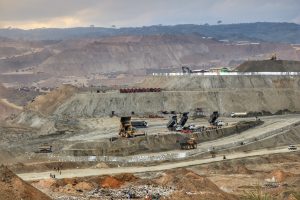China controls approximately 90 percent of the world’s rare earths processing. Its dominating position in the rare earth supply enables Beijing to weaponize its structural advantage in the high-tech industry and green energy transition.
Last week, China’s Ministry of Commerce tightened restrictions on rare earth exports, abruptly ending the tariff truce reached in May 2025. In response, the Trump administration threatened to impose tariffs of up to 100 percent on Chinese exports to the United States.
While the China-U.S. trade conflict continues to evolve, discussions about diversification of rare earth sourcing have been growing. Some actors have considered engaging with Myanmar, a major external supplier of rare earths to China. However, strategies to counter China’s rare earths monopoly must confront the entrenched and multilayered injustices underpinning the global supply chain. A case study of Myanmar’s rare earths reveals inequalities between the Global North and the Global South, between China and Myanmar, and between local powerholders and affected communities.
Since the 2021 military coup, which ended a decade of political liberalization, rare earth exports from Myanmar to China have sharply increased. Chinese customs data report that imports rose in value from $388 million in 2020 to $1.4 billion in 2023.
Most of Myanmar’s rare earth elements, especially heavy rare earths such as dysprosium (Dy) and terbium (Tb), are extracted from mines in Kachin State and Shan State, adjacent to China. In Kachin State alone, the number of mining sites increased from about 130 in 2020 to at least 370 in 2025, as revealed by satellite analysis from the Institute for Strategy and Policy.
These developments trace back to the post-coup collapse of public administration and intensifying armed conflict. The resulting flow of rare earths into China has reinforced Beijing’s dominance in the sector.
With that in mind, one proposed strategy for other countries to reduce dependence on Chinese rare earth imports involves engaging with Myanmar directly. Although many international stakeholders remain hesitant to cooperate with the military regime, some contemplate collaboration between the Kachin Independence Organization (KIO) and the United States, India, Australia, and Japan through the Quad grouping.
Engaging with Myanmar as an alternative supplier is not a simple solution to China’s monopoly. Doing so will only exacerbate entrenched injustice in the supply chain. Communities impacted by rare earth extraction have been sacrificed by the Global North countries, China, and Myanmar powerholders alike.
The pressing issue of climate change has prompted the Global North countries to reduce reliance on fossil fuels and transit to renewable energy. This caused increased demand for rare earth elements, which are indispensable to the manufacturing of electric vehicles and wind turbines. Yet the human and environmental costs borne by the Global South countries where these minerals are extracted have been neglected.
Despite its rich endowment of rare earth minerals, China expanded mining in Myanmar to avoid environmental and social costs at home – effecting outsourcing a heavily polluting industry. The mines in Myanmar use the in-situ leaching technique, in which ammonium sulphate is used to dissolve the rare earth ions from the mountains. The toxic waste released into groundwater, soil, and air is creating a long-term and large-scale environmental hazard.
In Kachin State, where part of the territory is occupied by the KIO, an ethnic resistance organization, social opposition to rare earth mining is visible. Local communities depend on natural resources for their livelihoods. The contamination of farmland and rivers by the chemicals used in the rare earth industry has ruined local economies.
In 2023, over 1,500 Kachin people categorically rejected the expansion of a rare earth mining project in Mansi Township owing to adverse environmental impacts. The KIO, which initially claimed that the rare earth revenue was needed to finance the armed resistance and public services, eventually suspended the project due to villagers’ mass protest. Nevertheless, the KIO continues to negotiate with Chinese mining companies regarding rare earth exports.
In other regions, forced displacement to make room for rare earth mining by the military and ethnic armed organizations is not uncommon. Civil society groups have therefore called for a halt in the trading of conflict minerals from Myanmar under the volatile political situations.
Global calls for a “just transition” to green energy must do more than address technical challenges. Robust ethical oversight to ensure community participation, environmental protection, transparency, and accountability across supply chains must be in place. Otherwise, the consumption of rare earths will only perpetuate the systematic exploitation of vulnerable communities.
Australia is striving to increase its rare earth production capacity. Its critical minerals reserve, technology, infrastructure, and regulatory framework make the country a strategic partner in rare earth supply. The cost of responsible rare earth sourcing, however, is expected to be higher.
Meanwhile, the Global North should cooperate with regional actors to step up political and economic pressure on Myanmar’s military junta to reinstate democratic governance and peace. In the absence of such reforms, initiatives for green energy transition and strategic trade diversification through Myanmar will not be feasible.




























